PDF chapter test TRY NOW
Some leeches eat worms, snails or insect larvae and some feed on the blood of fishes, animals and humans.
Blood is a rich source of nutrients for leeches. Its body is adapted in a way to attach and suck the blood from the host. The digestive system of the leech starts from the mouth and ends with the anus through into which sucked blood is digested.
In this object, the digestive system of the leech is explained.
Digestive system of leech:
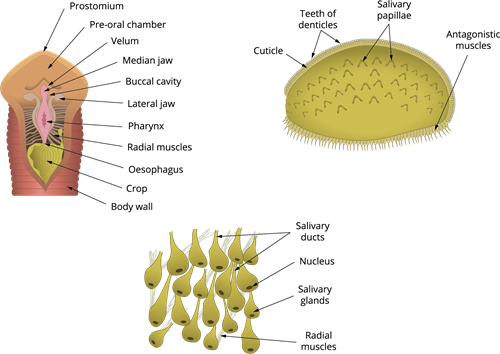
Digestive system of leech
Terms related to the digestive system of leech:
| Aperture |
|
| Triradiate |
|
| Papillae |
|
| Sphincters |
|
| Caeca |
|
| Proteolytic enzymes |
|
The digestive system of the leech includes the:
- Alimentary canal
- Digestive glands.
1. Alimentary canal:
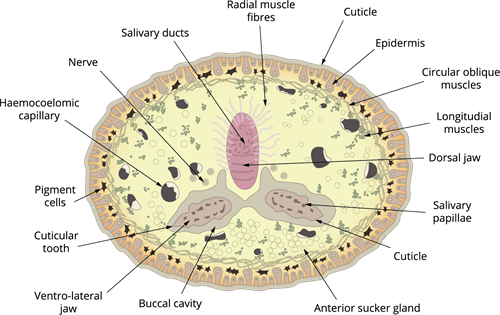
Transverse section body through buccal cavity
Leech's alimentary canal is a straight tube that connects the mouth to the anus. The mouth is a triradiate aperture that opens into the tiny buccal cavity and is located in the middle of the anterior sucker.
Three jaws with a single row of minute teethprotrude from the buccal cavity's wall. The jaws are equipped with papillae, which house the salivary gland openings. The mouth and buccal cavity occupy the first five segments.
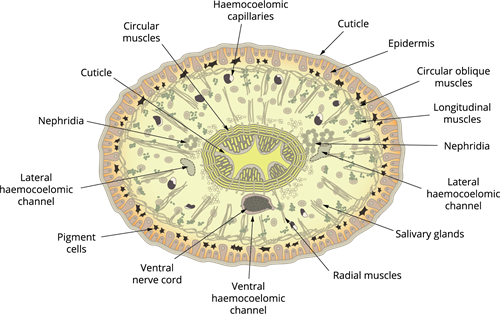
Transverse section through pharyngeal region
The muscular pharynx is reached through the buccal cavity. There are salivary glands all around it.
Saliva contains hirudin, a substance that stops blood from clotting.
A short and narrow oesophagus connects the pharynx to the crop.
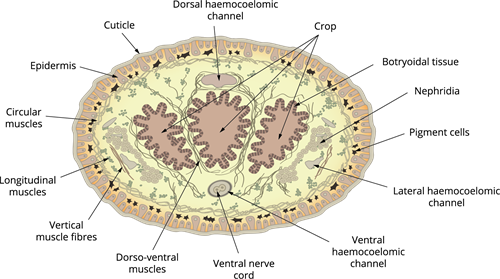
Transverse section through crop and its diverticula
The alimentary canal's crop is the largest part. It is separated into a ten-chamber system. Through circular apertures encircled by sphincters, the chambers communicate with one another. Each chamber produces a pair of lateral, backwardly oriented caecae, often known as caeca or diverticula.
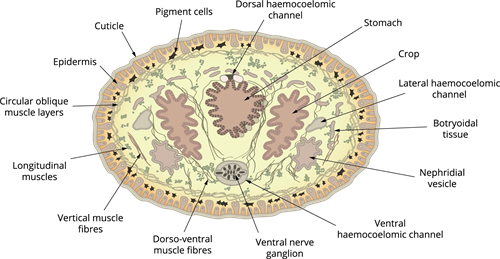
Transverse section body through the region of stomach
Crop's final chamber opens into the stomach. The stomach connects to the intestine, a small straight tube that leads to the rectum. The anus opens the rectum to the outside.
Food, Feeding and Digestion:
The blood of cattle and other domestic animals is used to feed the leech. During feeding, the leech uses its posterior sucker to attach itself to its host firmly. The leech's jaws extend through the mouth and form a triradiate or Y-shaped incision in the host's skin. The salivary secretion is poured after the muscular pharynx sucks the blood.
The blood of cattle and other domestic animals is used to feed the leech. During feeding, the leech uses its posterior sucker to attach itself to its host firmly. The leech's jaws extend through the mouth and form a triradiate or Y-shaped incision in the host's skin. The salivary secretion is poured after the muscular pharynx sucks the blood.
Leeches inject a protein called hirudinto keep blood from clotting. They also inject an anaesthetic substance to the victim, preventing them from feeling the bite.
- Leeches have no ears and can only detect vibrations through their skin.
- They have \(2\) to \(10\ \)small eyes that assist them identify their prey.
- They can suck five times their body weight in blood.
- It can take up to a year for a whole meal to be digested and absorbed completely.
Important!
The following table shows the segment location of the structures in the leech.

Segment location of the structures in the leech
External and Internal features | Segments in which the structures are present |
| Body segments | \(33\) |
| Anterior Sucker, Mouth, Eyes | \(1st - 5th\) |
| Posterior sucker | \(27th - 33rd\) |
| Pharynx | \(5th - 8th\) |
| Crop | \(9th - 18th\) |
| Stomach | \(19th\) |
| Intestine | \(10th - 22nd\) |
| Rectum | \(23rd - 26th\) |
| Anus | \(26th\) |
| Nephridiopores | \(6th - 22nd\) |
| Male genital aperture | \(10th\) |
| Female genital aperture | \(11th\) |
